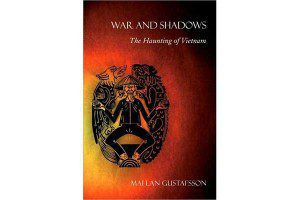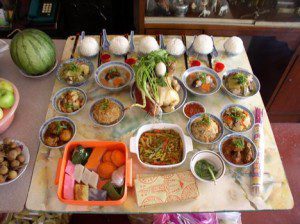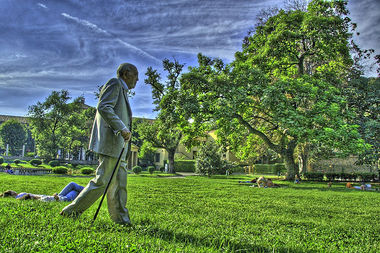Where do you go if you are bothered by angry ghosts? Traditionally, in a country like Vietnam where animism is strong, you would go to a diviner or medium to get a correct diagnosis of who is causing your problem, and to a shaman or exorcist to send it away. Though the Communist government outlawed all forms of spiritual practice, it’s still possible to find a medium or a “spirit priest” if you go about it discreetly.
Sam and his girlfriend agree they’ll go to a medium whose day job is as a fish vendor in the central market. They travel to her houseboat at night and wait for her all clear signal, a flickering light. In the session, Tuyet covers her face with a white cloth. She uses a scratchy tape of clicks and drums and a weird horn to get herself ready to receive. She starts speaking in a high, eerie voice. “He is Van Nguyen,” the voice begins. It describes the death of a 19-year-old Vietcong soldier, killed at the fence of a U.S. base in a welter of blood. Something was taken from his body before it was thrown in a hole and bulldozed over. “Is this him?” Sam holds out the ID card. “Yes, he is very angry.”
She tells Sam what to do. He must take the card to the boy’s mother and make his peace with the family. After Sam does to the mother with the identity card and offerings, his nights are quiet; the ghost no longer needs to scream through his vocal chords.
This is one of the cases recounted, as first-hand testimony and observation, in War and Shadows, a remarkable recent book on the war ghosts of Vietnam by Mai Lai Gustafsson. [1] She details no fewer than 190 cases of spirit possession or obsession (a useful old Church term she doesn’t actually use). All the others are the experiences of Vietnamese, mostly in Hanoi or the immediate vicinity. She attributes the willingness of so many Vietnamese informants to share their intimate secrets with her to two factors. She is half Vietnamese and (at the time of her fieldwork) she was enormously fat (over 300 pounds); she states that the Vietnamese regarded her obesity as a sign that she was a fellow-sufferer from ghost sickness.
“The Vietnam War has had an effect on both this world and the next,” writes Gustafsson, memorably. “Long after the peace treaties were signed, the war rages on in both realms: the battlegrounds are living human bodies; its warriors, the enraged ghosts who invade and assault them.” She finds an official high up in the Ministry of Health in Hanoi who is prepared to concede the extent of the problem, contrary to Communist orthodoxy. The war ghosts, he tells her, are “a national health menace.” Contrary to its own laws, it seems that the Vietnamese government now employs a select band of psychic mediums to locate missing dead and diagnose and treat egregious cases of ghost sickness.
Gustafsson includes a fascinating table at the end of her book summarizing the symptoms, diagnosis and treatment of her informants. Symptoms include head pains, depression and hearing voices to glossolalia, self-mutilation and violence against others. In most cases, the suffererers sought physical treatment – both traditional herbal remedies and Western medicine (when they could afford it) – before seeking a spiritual cure. The ones who found relief from their symptoms, according to Gustafsson’s data, are those who found effective ways to placate the angry ghosts and/or relocate them. Appeasing the restless dead might involve making offerings or changing personal behaviors. Methods of relocating souls might include staging a symbolic burial ceremony or “installing a spirit in a Buddhist temple”. My favorite example is of a man whose life was blighted by the presence of a deceased friend until he was finally guided to perform a ritual by which the energy of the dead man was transplanted to a bonsai tree.
Gustafsson’s information about the laying of ghosts in this second sense is limited because she made a point of not visiting the ritual specialists in the Buddhist pagodas or the gatherings of the popular cult of the Mother Goddesses (called Tu phu, the Religion of the Four Palaces) and does not appear to have had contact with anyone who could properly be termed a shaman, capable not only of channeling or dialoguing with the dead but of taking them where they need to go. She had her reasons – including the valid fear of encounters with the police – in not going further along this road, and must be commended for the great amount of fresh material she was able to collect.
However, the book is flawed by her failure to discuss the anatomy and variety of Vietnamese spirits. She contrasts the con ma (angry ghost) with the to tien (ancestral spirit) that is traditionally honored and fed at family altars, but this is not explored in detail. In Vietnamese animism – as in Chinese traditions, especially Taoism, which have greatly influenced Vietnam – multiple aspects of soul and spirit are recognized. They are identified with different parts of the body and have different destinies after death. For example, in Chinese vocabulary, the po soul, associated with the liver, is a lower entity that must be safely contained after death or it may trouble the living by joining the ranks of the kuei, the wild and hungry ghosts. By contrast, the shen spirit may ascend to higher realms and can function as a benign family helper.
Such distinctions are vital to our practical understanding of how to heal relations with the deceased. You can’t negotiate with the lower aspect of the dead; you need to get it off the living by other means and put it in a safe place. You can negotiate with a higher aspect of the dead, and in practice this is what is going on in some of Gustafsson’s success stories. Making and working such distinctions is the traditional province of the shaman, and we need to revive the shaman’s way of identifying, guiding and relocating the spirits because the problem of war ghosts is not confined to Southeast Asia. I chose the example of Sam, the one American in Gustaffson’s book, to suggest that dealing with war ghosts may be central to healing the wounded warriors among our vets in the United States and other Western countries.
I know this to be true from personal experience. Many years ago, a Vietnam vet came to one of my workshops. He had been a combat lieutenant and he lost every man in his platoon in a firefight, He had been haunted ever since by terrible dreams in which the ghost soldiers wanted to kill him, screaming at him that he had abandoned and betrayed them. In order to free him – and them – I had to lead and escort him in shamanic lucid dream journeys in which he dialogued, one by one, with the dead soldiers and made peace with them. He then agreed to perform a ritual of symbolic “second burial” to lay to rest the wild and unreasoning lower aspects of the dead.
Mai Lan Gustafsson has performed a distinct service in showing us how the ghosts of a collective tragedy can weigh on an entire people. I congratulate Cornell University Press for publishing this important study by an anthropologist who was not afraid to go “bicultural” twice over, in reporting from two worlds, in two senses.
[1] Mai Lan Gustafsson, War and Shadows: The Haunting of Vietnam (Ithaca and London: Cornell University Press, 2009)


